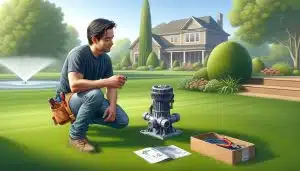Ultimate Guide on – HOW TO INSTALL A SUMP PUMP

Sump pumps come in handy in times of excess precipitation such as flood and storms. They help to channel away extra water and also play a vital role in keeping the basements free of the accumulation of water. But just what are they? And how can they be installed? We are here to examine both. For a start, a sump pump is a special kind of pump which is used to suck out excess water which has accumulated in the sump basins that accumulate water in the basements of homes. Some of these pumps are equipped with flood alarms and water levels. These alert the homeowners when the water reaches undesired levels. In the proceeding discussions, we are going to examine how to install these pumps as well as the factors you ought to consider while doing so.
TOOLS AND MATERIALS REQUIRED
You will first and foremost have to collect these tools and materials:
- Drill bits
- Electric drill
- Hammer
- Pipe cutter
- Pressurized fittings
- Wire Ties
- Gravel
- PVC pipe
- Corrugated pipe
- Cement
- Sump pump
- Check valve
- J hooks
- Increaser
- Silicone sealant
- Fittings
HOW TO INSTALL A SUMP PUMP – STEP-BY-STEP PROCEDURES
You will thereafter have to follow the procedures stipulated below:
Step I:
Identify the Location where the Water Accumulates Start by finding a suitable location to fix the sump pump. This should ideally be the lowest elevation in the area wherein the building is located. It should also be as close as possible to the Ground Fault Interrupter Outlet as this is where the sump pump will be fixed into.
Step II:
Bore the Hole for the Sump Next, dig a hole where you will subsequently lay the pump. This hole has to be 10 inches wider than the sump pump you intend to install. Once you have dug the hole, place some gravel to a depth of around 3 inches. Thereafter place the sump pump into this hole.
Step III:
Prepare the Sump Pump for Subsequent Operations Prepare the sump pump for subsequent operations. Do this by adding more gravel around the sump. Leave 1 or 2 inches of space at the top of the exposed sump.
Step IV:
Attach the Adapters Now proceed to attach the adapters to the Polyvinyl Chloride discharge pipe. Follow this by placing the female adapter on the sump pump. Use a ¼ inch drill to bore holes on the discharge pipe at a height of 6 inches above the pump. This hole, called a weep hole, gives room for water to flow back into the pump for it to function effectively.
Step V:
Fix in Place the Check Valve To do this, use wire ties to attach the electrical cord into the discharge pipe. Fix the check valve (which is meant for vertical operations) in place. Do this on the open end of the discharge pipe. Thereafter, place the pump into the sump and test to see whether it can run water successfully.
Step VI:
Direct the Water away from the Pump Channel the water away from the pump. Do this by using pressurized fittings as well as the 1.5-inch Polyvinyl Chloride pipe.
Step VII:
Run the Polyvinyl Chloride Pipe through the Wall After you have installed the Polyvinyl Chloride pipe you now have to pass it through the wall to let it channel the water away for safe disposal. To do this, install ‘J’ hooks in order to hang the pipe from the joists. Next, bore a hole through the wall that is adjacent to the sump pump. Do this by using a rotary hammer. Connect the pipe to the sewerage system for eventual disposal of the wastewater.
Step VIII:
Apply Silicone Sealant into the Hole Apply some Silicone sealant on the hole area where the pipe protrudes right through the wall. This is to shield your wall from moisture that may dampen and weaken that portion of the wall.
Step IX:
Direct the Flow of Water away from the Home Install the pump in such a way as to direct the flow of water as far away from the home as possible. Do this by attaching 1.5-inch wide by 3-inch wide increaser at the end of the pipe. Follow this by fixing a corrugated pipe on the end of the PVC pipe.
Step X:
Seal the Sump Place some gravel round and about the top of the sump pump. Plug the pump in. Finish off by placing a cover atop the sump.
THINGS TO CONSIDER ON HOW TO INSTALL A SUMP PUMP
The following are some factors to consider when installing a sump pump:
Soil Quality
Different soils have different textures, depth, porosity, and drainage patterns. These differences determine the depth at which you may dig the sump pump, how long it might last, and any reinforcements it may need among other vital parameters.
Drainage
As stated, drainage also does have an impact on the quality and the overall lifespan of the sump pump. This is because a poorly drained soil is more likely to accumulate plenty of water. This calls for a higher capacity pump with greater efficiency as well.
The depth of the Basement
Since the sump pumps are generally fixed at the basements of buildings, the depth of such basements also matter. This also determines the power of the pump you have to fix to ‘suck out’ the water from the sump. A deeper basement generally calls for a more powerful pump.
Location
Some jurisdictions may impose certain restrictions on the nature and extent of the pumps that are fixed there. Take this into consideration as well while contemplating fixing the sump pump in place. Crowded neighborhoods may also impose some restrictions on the dimensions and workings of these pumps.
Precipitation
Since these pumps are put in place to primarily channel away excess water, the amount of precipitation an area receives determines to a great extent the nature of their structure and workings. An area that receives abundant water similarly requires larger and more powerful sump pumps.
Underground Pipes and Sewage Lines
Before you embark on this installation, find out whether the area has any underground pipes and sewage lines. You do not want to get in trouble with the local authorities and sustain hefty fines, do you? Inquire from the city engineer the existence of such infrastructure and design your task in such a way as not to interfere with them.
FINAL VERDICT
Well, it is our hope that you have received the guidance you truly require to install the sump pumps. As you can see, carrying out this exercise requires a fair mastery of the needed technical skills. It also requires you to possess the relevant tools and materials. Unfortunately, you may not really meet these two preconditions. This is why we urge you to delegate the responsibility to a qualified expert.
Check out best submersible pump



